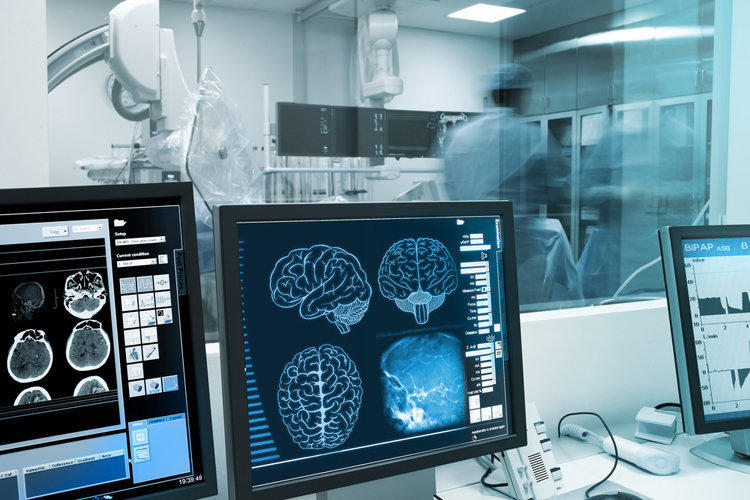- Alzheimer’s Disease: Causes of Disease Development
- Alzheimer’s Cholinergic Hypothesis
- Amyloid Hypothesis
- Tau hypothesis
- Hereditary Hypothesis
- Alzheimer’s Disease: Symptoms at Different Stages
- The first signs of the disease
- Alzheimer’s Disease Stages
- Early Stage: Predementia
- Early Dementia
- Stage of moderate dementia
- Severe Dementia
- Alzheimer’s Disease Diagnostic Methods
- Problems of early diagnosis of the disease
- Typical clinical manifestations of the disease
- Alzheimer’s Disease Test
- Neuroimaging Techniques
- Magnetic resonance imaging
- Computed tomography of the brain
- Advanced Diagnostic Methods
- Alzheimer’s Disease Treatment
- Drug Therapy
- Alzheimer’s Disease: Prevention Methods
Alzheimer’s disease is a neurodegenerative disease, one of the common forms of dementia, “senile dementia.” Most often, Alzheimer’s disease develops after 50 years, although there are cases of diagnosis in earlier age periods. Named for the German psychiatrist Alois Alzheimer, the disease is currently diagnosed in 46 million people in the world and, according to scientists, this figure may triple in the next 30 years. The causes of Alzheimer’s disease have not yet been established, just as an effective drug for the treatment of this disease has not been created. Symptomatic therapy in Alzheimer’s disease can mitigate the manifestations, but it is impossible to stop the progression of an incurable disease.
Alzheimer’s Disease: Causes of Disease Development

It is argued with a high degree of confidence that the main cause of Alzheimer’s disease is amyloid deposits in the brain tissues, causing neural connections and cell death, which leads to the degeneration of the medulla.
Amyloid deposits are formed in two variants. Amyloid plaques that form first in the tissues of the hippocampus, and then spread to the entire brain, prevent the organ from performing its functions. Amyloid increases the concentration of calcium in brain cells, which causes their death.
The second type of deposits is neurofibrillary tangles, one of the discoveries of Alois Alzheimer’s. Discovered when studying the brain of a deceased patient, the tangles consist of insoluble tau protein, which also disrupts normal brain function.
The causes of deposits leading to the development of Alzheimer’s disease have not been precisely established. Neurodegenerative diseases of the brain have been known for a long time, however, Alzheimer’s disease was isolated from a number of dementias in 1906 due to A. Alzheimer, who for several years observed a patient with progressive symptoms. In 1977, at a conference on degenerative diseases of the brain and cognitive disorders, Alzheimer’s disease was isolated as an independent diagnosis due to the prevalence of the disease and the need to find the causes of its development and treatment methods. At the moment, there are a number of hypotheses and assumptions about the mechanism of the occurrence of brain dysfunction characteristic of this disease, and the principles of maintenance therapy of patients have been developed.
Alzheimer’s Cholinergic Hypothesis
The first studies conducted to study the causes of the disease, revealed a deficiency of the neurotransmitter acetylcholine in patients. Acetylcholine is the main neurotransmitter of the parasympathetic nervous system and is involved in the transmission of nerve impulses between cells.
This hypothesis led to the creation of medicines that restore the level of acetylcholine in the body. However, in the treatment of Alzheimer’s disease, the drugs were ineffective, although they reduced the severity of symptoms, but did not slow the progression of the disease. Currently, drugs of this group are used in the course of maintenance therapy of patients.
Amyloid Hypothesis
The amyloid hypothesis, based on the destructive effect of beta-amyloid deposits on brain cells, is currently the main one. Despite the reliability of data on the action of beta-amyloid, the cause of its accumulation in brain tissue is unknown. Also, a drug that prevents its accumulation or promotes resorption of amyloid (senile) plaques is not created. Created experimental vaccines and drugs aimed at cleansing brain tissue from excess beta-amyloid, have not passed clinical trials.
Tau hypothesis
The Tau hypothesis is based on the identification of neurofibrillary tangles in brain tissue arising from disturbances in the structure of the tau protein. This assumption about the causes of Alzheimer’s disease is recognized as relevant along with the hypothesis of amyloid deposits. The causes of violations are also not identified.
Hereditary Hypothesis
Thanks to years of research revealed a genetic predisposition to Alzheimer’s disease: the frequency of its development is much higher in people whose relatives suffered from this disease. The development of Alzheimer’s disease is “blamed” on chromosomes 1, 14, 19, and 21. Mutations in chromosome 21 also lead to Down’s disease, which has similar degenerative phenomena in brain structures.
Most often, a type of “late” Alzheimer’s disease that develops aged 65 years and older is genetically inherited, but the “early” form also has genetic disorders in etiology. Chromosomal abnormalities, inheritance of genome defects do not necessarily lead to the development of Alzheimer’s disease. Genetic predisposition increases the risk of the disease, but does not cause it.
If there is a hereditary risk group, preventive measures are recommended, mainly related to maintaining a healthy lifestyle and active intellectual activity: mental work contributes to creating more neural connections, which helps the brain to redistribute functions to other areas when a part of the cells die, probability of developing symptoms of senile dementia.
Alzheimer’s Disease: Symptoms at Different Stages

Alzheimer’s disease is a neurodegenerative disease in which brain cells die. This process is accompanied first by impaired cognitive functions, and at later stages by the inhibition of the functions of the whole organism.
Despite the variability of symptoms depending on the patient’s personality, the general manifestations of the pathology are the same for everyone.
The first signs of the disease
First of all, short-term memory suffers with long-term safety. Complaints of elderly people about forgetfulness, seeking to receive the same information several times are typical enough both for the age peculiarities of brain functioning and for the first stages of Alzheimer’s disease. In the presence of the disease, forgetfulness increases, it becomes difficult to process new information, remember not only the locations of the usual things, but also the names of relatives, their age, basic information.
The second symptom of an early stage of the disease is apathy. The interest in habitual forms of pastime decreases, it becomes more difficult to go in for your favorite hobby, go out for a walk, meet friends. Apathy comes to the loss of hygienic skills: patients stop brushing their teeth, wash and change clothes.
Common symptoms also include speech disorders, starting with an attempt to recall a familiar word and ending with a complete inability to understand what was heard, read and the speech itself, isolation, separation from loved ones, spatial orientation disorders: difficulty recognizing places, losing the way home, etc. .
In men, the state of apathy is often replaced or alternated with heightened aggression, provocative behavior, and sexual behavior disorders.
Often, early diagnosis of the disease is impossible, because the patients themselves do not realize the symptoms of the pathological process that has begun or relate them to manifestations of fatigue and stress. One of the common mistakes at this stage is the attempt to “relieve tension and relax” with the help of alcohol: alcoholic beverages significantly accelerate the death of brain cells and cause an increase in symptoms.
Alzheimer’s Disease Stages
Alzheimer’s disease affects brain tissue, leading to progressive cell death. The process begins in the hippocampus, responsible for storing and using the accumulated information, and extends to other departments. Damage to the cerebral cortex causes cognitive impairment: logical thinking suffers, ability to plan.
Mass cell death leads to the “drying out” of the brain, reducing its size. With the progress of Alzheimer’s disease, the disease leads to a complete degradation of the brain functions: the patient is not capable of self-care, cannot walk, sit, eat on his own, in the later stages chew and swallow food. There are several classifications of the stages of Alzheimer’s disease. The most common are four stages of the disease.
Early Stage: Predementia
This stage precedes the pronounced clinical picture of the disease. When making a diagnosis on the basis of overt symptomatology, the patients themselves and their relatives recall that the first signs of Alzheimer’s disease manifested themselves for several years (on average 8), but they were counted as consequences of fatigue, stress, age-related decline in memory processes, etc.
The main symptom of this stage is a breach of short-term memory: the inability to remember a short list of products to buy in the store, a list of classes for the day, etc. The increasing need for entries in the diary, smartphone, progressive household forgetfulness, and a decrease in the number of interests increasing apathy, the desire for isolation.
Early Dementia
It is at this stage that the clinical diagnosis most often occurs. The destruction of brain cells and neural connections spreads from the hippocampus to other parts of the brain, the symptoms increase, it becomes impossible to attribute them to the effects of fatigue or overstrain, patients themselves or with the assistance of relatives go to the doctor.
New symptoms, often at the first stage, associated with speech, join memory and apathy disorders: the patient forgets the names of the objects and / or confuses words that sound like, but differ in meaning, the words. Motor disturbances are added: the handwriting deteriorates, it becomes difficult to put things on the shelf, in the bag, to cook food. The overall impression of slowness and clumsiness is due to the dystrophy and cell death in the hotel of the brain, which is responsible for fine motor skills.
As a rule, at this stage, most people cope with the majority of everyday tasks and do not lose their self-service skills, however, from time to time they may need help in performing usual tasks.
Stage of moderate dementia
The stage of moderate dementia in Alzheimer’s disease is characterized by an increase in the symptoms of the disease. There are marked signs of senile dementia, disturbances of mental processes: difficulties in building logical connections, planning (for example, inability to dress in accordance with the weather). Spatial orientation is impaired, patients who are out of home cannot understand where they are, which, together with short-term and long-term memory disorders characteristic of this stage, makes it impossible to remember how a person got into this place and where he lives, how his and his family’s names are.
Violations of long-term memory lead to the forgetting of the names and faces of native, personal passport data. Short-term memory is reduced so much that patients do not remember eating a few minutes ago, they forget to turn off the light, water, gas.
Speech skills are lost, it is difficult for patients to remember, select words for everyday speech, reading and writing abilities decrease or disappear.
There are marked fluctuations in mood: apathy is replaced by irritation, aggression.
Patients at this stage require constant supervision, although some self-care abilities still remain.
Severe Dementia
Alzheimer’s disease in the stage of severe dementia is characterized by a complete loss of self-care, self-feeding ability, the inability to control physiological processes (incontinence, fecal masses), almost complete loss of speech, progressing to a complete loss of the ability to move, swallow.
Patients need constant care, at the final stage food is supplied through a stomach tube.
Alzheimer’s disease itself is not fatal. The most common cause of death is pneumonia, septic, necrotic processes due to the appearance of pressure sores, adherence to Alzheimer’s disease of a different etiology, depending on the individual characteristics of the person.
Alzheimer’s Disease Diagnostic Methods

Early diagnostic measures help to compensate for existing disorders and slow down the development of the neurodegenerative process. If you detect characteristic neurological signs, you should consult a specialist to identify the causes of their occurrence and correct the condition.
Problems of early diagnosis of the disease
The main reason why the disease is not diagnosed at an early stage of predementia is a careless attitude to the manifestation of primary symptoms, as well as a decrease in the patient’s ability to adequately assess his or her condition, which also manifests at the onset of the disease.
Forgetfulness, distraction, motor awkwardness, decrease in working capacity, which are not compensated by rest, should become the reason for a full-fledged examination by a specialist. Despite the fact that the average age of the onset of Alzheimer’s disease is 50-65 years old, the early form begins at the turn of 40 years, and the cases of the onset of pathology at the age of 28 are known to medicine.
Typical clinical manifestations of the disease
When collecting patient history and analyzing patient complaints, the specialist differentiates them according to the clinical picture of the disease: progressive impairment of memory functions, from short-term to long-term, apathy, loss of interests, decreased performance, activity, mood swings. Often, these symptoms reveal symptoms of depression, caused by the awareness of a decline in brain function, dissatisfaction with one’s abilities, condition, and attitude of others.
Alzheimer’s Disease Test
Alzheimer’s disease is a disease that, in its external manifestations, may be similar to both temporary conditions caused by transient disorders and some other pathologies. For the initial confirmation of the diagnosis, the specialist cannot be based only on the results of collecting information from the patient and his relatives, therefore, tests and questionnaires from various sources are used to clarify.
When testing, the patient is asked to memorize and repeat several words, read and retell unfamiliar text, perform simple mathematical calculations, reproduce patterns, find a common feature, orient in temporal, spatial indicators, and so on. All actions are easily performed with intact neurological functions of the brain, but cause difficulties during the pathological process in the brain tissues.
These questionnaires are recommended for interpretation by experts, but can also be used independently at home. Some results interpretation tests are available on the Internet.
Neuroimaging Techniques
The clinical picture and neurological symptoms in different neuro-diseases are similar, so Alzheimer’s disease requires a differentiation of the diagnosis from vascular brain disorders, the development of cystic inclusions, neoplasms, the effects of stroke.
For accurate diagnosis resort to instrumental methods of examination: MRI and CT.
Magnetic resonance imaging
Magnetic resonance imaging of the brain is the preferred method of investigation for suspected Alzheimer’s disease. This neuroimaging technique can reveal characteristic symptoms of the disease, such as:
- decrease in the amount of brain matter;
- inclusions;
- metabolic disorders in brain tissue;
- expansion of the ventricles of the brain.
MRI is performed at least twice every month to assess the presence and dynamics of the degenerative process.
Computed tomography of the brain
Computed tomography is another neuroimaging method used in diagnosis. However, lower, compared with MRI, the sensitivity of the device allows us to recommend it to diagnose the state of brain tissue in the later stages of the disease, when brain damage is quite significant.
Advanced Diagnostic Methods
Positron emission tomography is considered the most modern diagnostic method, allowing to determine the disease even at the earliest stages. This technique has limitations for patients with an increased concentration of sugar in the blood, since a pharmacological preparation is administered to the patient to accurately determine the presence of irregularities in the intracellular metabolism of brain tissue. No other contraindications to PET have been identified.
For additional diagnostics in cases of suspected Alzheimer’s disease, differentiation from other diseases and assessment of the patient’s condition, EEG, laboratory tests of blood, plasma (NuroPro test), spinal liquor analysis can be performed.
Alzheimer’s Disease Treatment
Alzheimer’s disease is an incurable disease, so therapy is aimed at combating the symptoms and manifestations of the pathological process and, if possible, slowing it down.
Drug Therapy
In accordance with the research conducted, groups of drugs were found to reduce the formation of deposits that destroy brain cells, as well as drugs that help improve the quality of life of patients. These include:
- anticholinesterase group: Rivastimine, Galantamine, Donezipin in various forms of release;
- Akatinol memantine and analogues that counteract the effects of glutamate on brain cells;
- symptomatic drugs: amino acids, medications that improve cerebral circulation, reduce increased psycho-emotional stress, manifestations of mental disorders in the late stages of dementia, etc.
Alzheimer’s Disease: Prevention Methods
Alzheimer’s disease is a disease in which the brain loses its function due to cell death and disruption of neural connections. However, it has been proven that the human brain is sufficiently plastic, the cells and parts of the brain can partially replace the affected areas, performing additional functions.
In order to provide the brain with an opportunity for such self-compensation, the number of neural connections must be high enough that occurs in people with mental activity, intellectual hobbies, and a variety of interests. Studies show that Alzheimer’s disease is directly correlated with the level of IQ: the higher the intellect, which means the number of stable neural connections in the brain, the less often the disease appears.
It is also known about the relationship between learning foreign languages and the development of senile dementia: the more knowledge, the lower the risk of falling ill. Even at the initial stage of the disease, it is possible to slow the development of symptoms, if you actively begin to train memory, read and retell information, solve crossword puzzles. Alzheimer’s disease is a disease that destroys neural connections, and its impact can be countered by the creation of new ones.
The methods of prevention also include a healthy lifestyle, physical activity, a balanced diet, avoiding alcohol. It is not yet known what mechanisms provoke Alzheimer’s disease, but there is evidence that head injuries can also cause the onset of the disease. Injury prevention also serves to prevent Alzheimer’s disease, a disease that violates the quality of life of not only the patients themselves, but also their families and friends.






